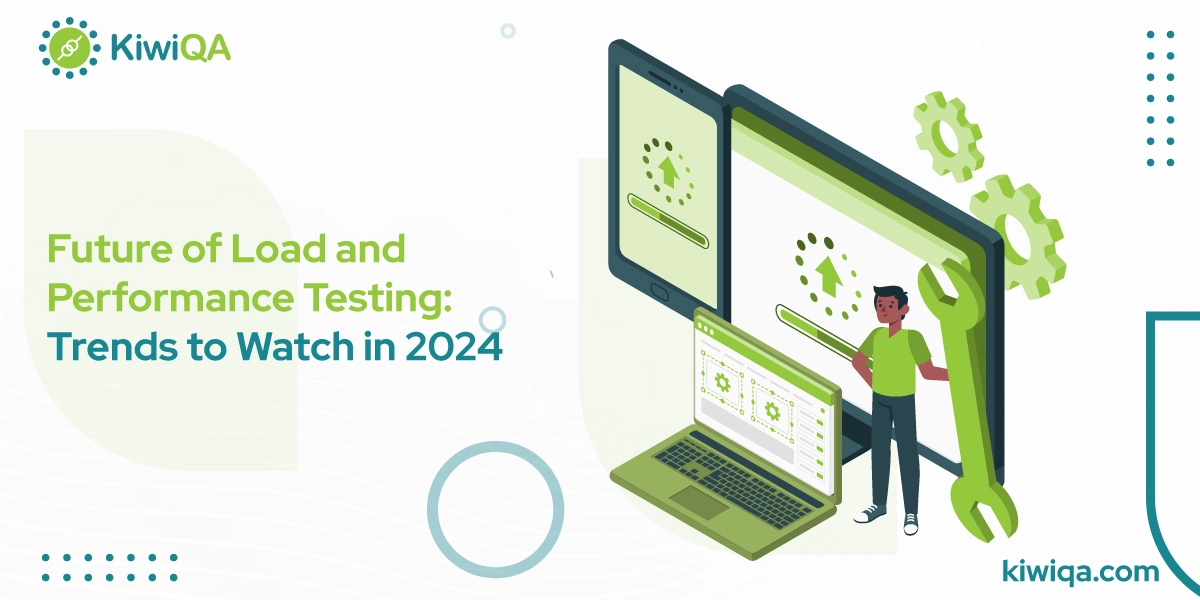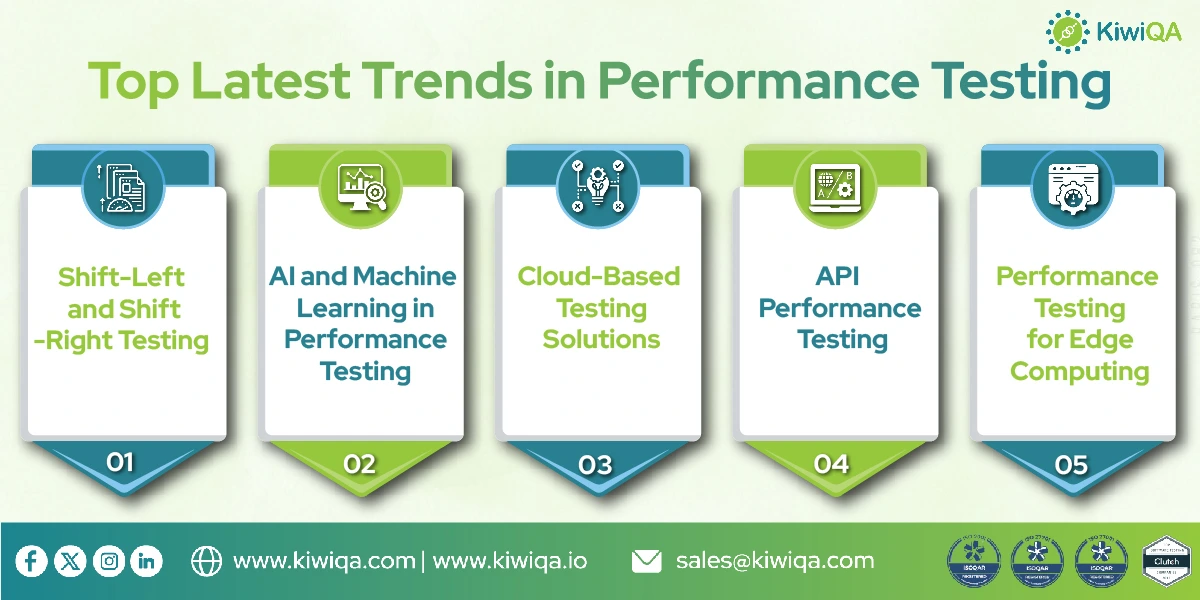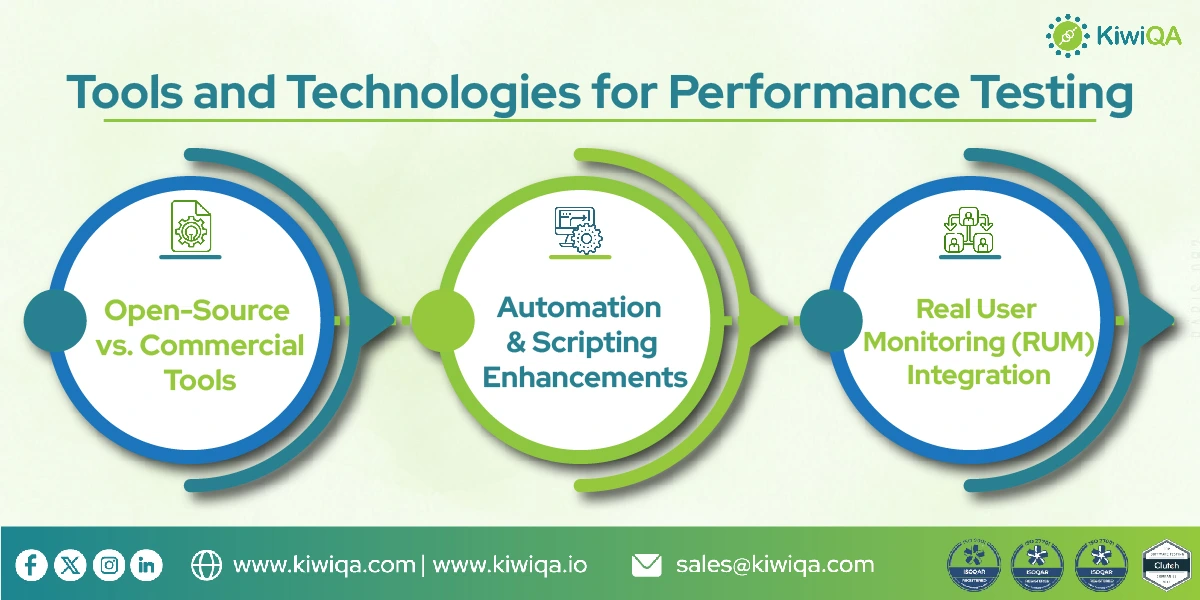Do you ever want to use an application that is unresponsive, slow, and shows errors every time? No right? Software performance is the key element in the success of any software. Slow response & frequent errors can drive the users away. This is when load & performance testing comes to the frame. The future of performance testing is bright since it assists in reviewing the application speed, its ability to handle the load & responsiveness. Based on Precedence Research, the market of global cloud computing is expected to grow by $1 trillion at the end of 2028. It ensures the software runs smoothly & matches non-functional needs like security, scalability, and reliability.
The quality of your software increases the audience. In 2024, companies are prioritizing to guarantee optimal app performance. The performance testing trends are getting popular, boosting the user experience & safeguarding the system from multiple failures. By considering the advancement in 2024, the market has released multiple trends & future performance testing to look for. Through these pots, we’ll try to make our users aware of them.
The Evolving Landscape of Load and Performance Testing
Performance testing services verifies the responsiveness, speed, and software stability under specific loads. Load & performance testing is the comprehensive testing approach that aims to measure and remove performance errors before software is exposed in the market. To know more about the future of performance testing, read the blog till the end.
In 2024, the competition is high, and that’s why companies are putting all possible effort into standing over their competitors. They prioritize making their application stable under high traffic and maintaining integrity under stress. Load & performance testing trends are necessary to improve the user experience by minimizing delays & avoiding crashes in peak hours.
When discussing load testing, load testing is a crucial part of performance testing. The goal of this testing is to verify how well the software application manages the expected traffic & load. Through this testing, a business can test their application performance under regular & peak load situations. Load testing aims to mimic the expected & high user traffic to verify the software is reliable & robust.
➯ Increased Demand for High-Performance Applications
The mobile application industry in 2022 has contributed 206.85 billion dollars. The market of performance testing trends is already growing like a skyrocket with huge popularity across multiple mobile app development types. The market is filled with a vast number of mobile applications, including healthcare, networking, eCommerce, entertainment, etc. There are multiple other market research studies that show promising market growth.
There is a high demand for applications that are high in aspects of stability, ease of use, reliability, zero errors, and faster response. Now, users don’t have much time to go through each and every application feature. If an application is not performing well on their device, like security loopholes, delay in loading time, messy UI, or errors in navigation, they uninstall the application in no time.
If you don’t want to get these responses from your users, then it’s necessary to opt for continuous performance testing trends before the application is released. Regular testing for performance verifies that the app is running smoothly and securely. Now, people expect high outputs, but they have less patience. Performance testing plays a key role in matching their expectations.
Also Read: Importance of Performance Testing in Your Development Cycle
➯ Complexity of Modern Applications
With the advancement in consumer demand and advances, the pressures on companies are getting high. They are under peak pressure to release faster, more scalable, and more responsive applications in the market. The legacy monolithic apps, once considered cutting-edge, are increasingly creating a hindrance to growth.
To match the expectation of consumers to use modern applications, organizations are transforming to Microservices and containerization. Companies can unlock the power of Microservices and containerization by deploying the monolithic application & leveraging the DDD principles.
The increasing demand for continuous performance testing trends makes businesses able to deliver unparalleled scalability and efficient applications to the world. Now, a huge number of businesses are moving towards the hybrid multi-cloud approach. It seamlessly merges its premises infrastructure with a plethora of cloud services from multiple providers. The following multi-cloud environment brings new complexities. The common issues are navigation to manage the various cloud interfaces and fragmented data distribution across the platforms.
Top Latest Trends in Performance Testing in 2024
1. Shift-Left and Shift-Right Testing
In this world of high expectations from software development, verifying the reliability & security, and quality of applications is important. To fulfill the goal & consumer expectations, the developers and testers utilize multiple software testing methodologies & continuous performance testing trends. Shift left & shift right testing is one of those approaches that is receiving the highest attention in the market. Both approaches have the potential to uncover the errors earlier in the SDLC & boost continuous changes.
Shift left & shift right are 2 different latest trends in performance testing agile DevOps methodologies. The methodologies boost the application development and also verify software quality. Both techniques are becoming popular since they are measured in the SDLC initial phases. Both testing principles are popular for integrating performance testing in the CI/CD pipeline to develop a consistent testing environment for testing techniques.
In the traditional development & testing process, performance testing is carried out in the last stage of development. In the latest trends in performance testing shift approach, it is performance testing performed in the earlier software development lifecycle. Testing the software in early SDLC assists in tracking potential errors quickly and lowers the chances of delays.
Based on the research by Capgemini, the companies that integrated the shift-left testing approach witnessed a 30% testing time reduction and a 20% decrease in the cost of projects.
Shift right testing is as popular as production testing, which aims to collect real-time information and perform tests live. The performance testing latest trends approach delivers valuable insights into how the software performs in real-time scenarios. The testing enables tracking of potential issues that arise at the time of deployment & at the time of application usage by end users.
2. AI and Machine Learning in Performance Testing
In this competitive industry, the popularity of AI and ML is reshaping the field of software development. In 2024, companies are integrating AI & ML in performance testing since these latest trends in performance testing have the power to transform the way of performance testing. The following trends in integrating AI and ML make the performance testing process more accurate, efficient, and quick. Collaborating AI & ML in the field of software development ensures higher-quality software production.
Earlier, businesses relied only on the limited data scientist pool for algorithm development. However, today, with the help of AI & performance testing latest trends, the technologies become more accessible. Furthermore, it reaches a huge audience pool and allows various levels of data scientists to harness the potential of AI. Now, businesses use AI in testing approaches to identify the changes that damage the app’s performance. The following proactive optimization avoids issues that affect users and forces them to stop using an application.
Embracing the involvement of performance testing latest trends, such as ML and AI, in performance testing brings benefits to testers, developers, and organizations. It improves the quality and efficiency of performance testing. Integrating these smart technologies in performance testing lowers the time required to conduct testing and removes manual errors.
The performance testing latest trends, such as AI & Machine learning tools, allows individuals with vast skill levels to execute testing. Utilizing these into testing frameworks can be a game changer for testers. Through this, you can auto-generate the tests, balance the existing testing scripts, measure failures, duplicity, and errors in the code, design and manage data, wipe down crucial data, and more.
3. Cloud-Based Testing Solutions
Cloud performance, the new trend in performance testing, is a methodical assessment procedure that examines services and apps housed in a cloud setting. Furthermore, its objective is to evaluate their overall efficiency, scalability, dependability, and responsiveness. To evaluate how well the cloud infrastructure manages anticipated workloads, the testing technique simulates a range of user loads and situations.
When measuring cloud performance, there are specific considerations to consider, such as response time, memory, network resource consumption, error rates, etc. Finding potential performance difficulties, making sure SLAs are followed, and confirming that the system can maintain peak performance and accessibility in both typical and high-demand scenarios. With the integration of cloud performance testing, businesses can expect cost reduction. They can also expect improved scalability and quality outcomes.
4. API Performance Testing
Advanced software applications are built using APIs in today’s fast-paced digital world. A smooth and efficient user experience depends on them operating at peak efficiency. This is where proficiency in API performance testing comes in handy. Understanding API performance testing necessitates a systematic approach. Conducting thorough API performance testing requires selecting top-notch API performance testing tools. These are a few widely used tools mentioned below:
-
JMeter Apache:
This popular open-source tool contains powerful features. Its versatility for testing different kinds of APIs arises from its compatibility with many protocols.
-
Postman:
An all-inclusive platform for developing and testing APIs that streamlines the process of designing and running API performance tests. It has an array of functions and an easy-to-use interface.
-
Gatling:
This is a Scala-based open-source framework for load testing. Developers choose it because of its efficient and real-time scenario simulation architecture.
5. Performance Testing for Edge Computing
Software and hardware are both necessary for computing. Performance testing views the underlying hardware as a steady and predictable simulated layer. As long as you’re working with the kinds of gear found in data centers, the majority of the time, yes. However, moving outside of the data center makes things more challenging. To achieve optimal performance under varying situations, edge computing, the new trends in performance testing, entails simulating numerous edge computing scenarios.
Establishing the operation, efficiency, safety, and compatibility of applications and network elements that operate on edge or virtualized platforms is an intimidating task when testing edge computing. Testing is done primarily to check functionality, analyze security, and measure performance in order to make sure the demands are satisfied, quality of service is provided, harmful assaults are resisted, and laws are followed.
Also Read: Top Mobile App Performance Testing Tools: To Watch in 2024
Emerging Tools and Technologies for Performance Testing
➯ Open-Source vs. Commercial Tools
The open-source test automated performance testing tools are tools that are available for free to use, distribute, and modify. The most popular tools for open-source tools are Selenium, Cucumber, Test NG, Robot Framework, Appium, Apache JMeter, and Cypress. The above-mentioned open-source performance tools drive various advantages.
Compared to commercial tools, these are free to use and have a huge active community for developers and users. The huge team of community supports developers and users to make the testing process more flexible and efficient. There are specific drawbacks to open-source tools, such as low stability, quality, and security. Furthermore, it may have limited features, support & documentation as compared to the commercial tools. Because of these cons, vendors choose commercial testing tools for their projects.
Moreover, the commercial automation performance testing tools are designed and developed by experts. The major key players of commercial tool providers are Ranorex, Katalon Studio, UFT, etc.
The commercial & new trends in performance testing tools are more scalable, secure, and consistent as compared to open-source tools. These tools come with good features, better documentation, and 24/7 support. Furthermore, it matches the requirements of industries & customer expectations. The best thing about this tool is it can work in any type of system and device. However, it might be expensive, so if you have a good budget for testing your software, it would be the right option for you.
➯ Automation and Scripting Enhancements
Performance scripting enhancements and automation are the programming codes that are specific to automate real-world user behavior. Moreover, the code covers the real user actions on the application. These new trends in performance testing scripts are designed through performance testing tools such as JMeter, LoadRunner, etc.
The goal of the performance scripting enhancement tool is behavior simulation of real-world users. Digital users utilize these scripts to generate desired stress on the website. A few of the testing scripts are Java MQ triggers.
➯ Real User Monitoring (RUM) Integration
RUM tracks the functionality of a page using the computers of actual users. In order to monitor and provide page load statistics for each request performed, a third-party script often injects a script on each page. This method keeps track of real-time user interactions within an application. Actual user’s browsers provide performance data they have encountered in real user monitoring.
RUM assists in determining the manner in which an application involves the user’s location. This is especially crucial for huge websites or intricate apps whose content or functionality is ever-changing. An organization can get a brief about their custom activities on software through RUM. They can also determine which parts of their website need the most attention by utilizing RUM.
Predictions for the Future of Performance Testing
➯ The Role of Quantum Computing in Performance Testing
The financial, AI, and pharma industries face some common issues because of the system complexities & various interdependencies. Quantum computing in performance testing plays a strong role in ensuring the safety and performance of any software.
Software may be tested under specific situations since quantum computers can replicate complicated systems precisely. These models are popular for testing AI programs & financial models. It is also popular for analyzing a huge volume of data and processing a massive bunch of data. Security is the common aspect where quantum computing has a huge effect on quality assurance. Because of the ability to break through multiple encryption strategies, quantum computing poses an extreme threat to cybersecurity.
➯ Integration of Performance Testing with Observability Platforms
The observability testing tools follow the new code-centric testing approach. The tools assist in gathering and offering useful information on the app backend by following the performance testing runs. Observability allows you to know the areas where you lack the ability to enhance software quality.
With the top-notch observability solution, the team can receive alerts about issues & proactively resolve them before they start hampering users. Performance Testing with Observability Platforms eases the testing team’s efforts by improving the testing process. It delivers a brief understanding of software performance and behavior.
➯ Evolution of User Expectations and Testing Standards
With the inventions of tools and digital transformation, the expectations of users and testing standards are also increasing. Performance testing is the essential step in the SDLC process. Now, users are expecting more and more, and that’s why companies are evolving into advanced tools. Performance testing is the basic component of SDLC, and it verifies that the product matches the necessary standards and functions.
For years, the industry witnessed a sudden shift in the testing standards, moving from testing manually to adopting automated testing practices. Now, users also expect reliable and quick response software. Because of the rising expectations of users, testing companies are now prioritizing testing the application with advanced tools that are shaping the future of testing practices.
Maximize Your App’s Performance: Get a Free Consultation Today!
Monitoring the performance of software is necessary since it allows companies to identify and resolve errors in performance. It ensures the app’s smooth functioning and success. As we land in the year 2024, it’s necessary to unlock the testing trends that reshape the future.
Businesses, as well as individuals who want to thrive in this digital era by releasing their well-performing software, should closely monitor these trends. If you are a newbie, get assistance from the performance testing company. The ideal companies adapt and explore new tools & methodologies and are aware of the same.









